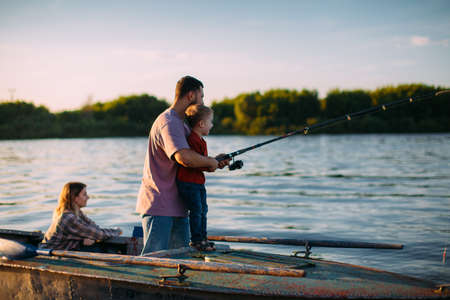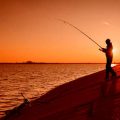Exploring Ice Fishing in the Lower 48
For passionate anglers, ice fishing isn’t just a winter hobby — it’s a way of life. And while places like Alaska and Canada often steal the spotlight, there are countless hidden gems for ice fishing right here in the continental U.S., also known as the Lower 48. What truly sets these destinations apart is their remote, untouched charm. Far from busy highways and crowded lakes, these spots offer something special: solitude, pristine nature, and the thrill of finding fish where few others venture.
Remote ice fishing escapes provide more than just great catches — they offer peace and quiet, time to reconnect with nature, and a break from everyday stress. Many die-hard anglers are drawn to these secluded areas because they offer a unique kind of challenge and reward. You’re not just dropping a line; you’re trekking into wild terrain, setting up camp on a frozen lake, and testing your skills in some of the most rugged winter conditions the Lower 48 has to offer.
But what makes an ice fishing spot truly “remote”? It’s usually a mix of limited access, low population density, fewer amenities, and minimal tourist traffic. These places might require snowmobiles or long hikes to reach. You won’t find fancy lodges or bait shops around every corner — and that’s exactly why serious anglers love them.
Why Choose Remote Over Popular?
| Remote Ice Fishing | Popular Ice Fishing Spots |
|---|---|
| Quiet, peaceful environment | More people and noise |
| Less fishing pressure on lakes | Higher competition for spots |
| Adventure and exploration | Easier access, less effort needed |
| Unspoiled natural beauty | More development nearby |
If youre someone who enjoys blazing your own trail and escaping into true winter wilderness, these remote locations across the Lower 48 will be right up your alley. Whether youre setting up your shack on a frozen alpine lake or drilling through the thick ice of an isolated reservoir, youll find that the experience is about much more than just catching fish — its about the journey, the silence, and the satisfaction of doing things the hard (and rewarding) way.
2. Minnesota’s Frozen Wilderness: Lake of the Woods
When it comes to remote ice fishing getaways in the Lower 48, Lake of the Woods in northern Minnesota stands out as a true winter angler’s paradise. This massive lake straddles the U.S.-Canada border and offers one of the most expansive frozen fishing playgrounds youll find without heading into Alaska. For those seeking solitude, adventure, and the chance to hook into legendary walleye, this is your spot.
Why Lake of the Woods?
This area isn’t just big—it’s wild. With over 14,000 islands and more than 65,000 miles of shoreline (yes, you read that right), it’s easy to find a secluded corner all to yourself. Once winter sets in and the lake freezes solid, anglers roll out their gear and set up everything from simple pop-up shelters to fully equipped ice fishing houses.
What Makes It Special?
- Epic Walleye Fishing: Known for producing trophy-sized walleye and sauger.
- Remote Vibes: Even with popular access points like Baudette and Warroad, you can venture far enough out to feel completely off-grid.
- Ice Roads: Maintained by local resorts, these icy highways lead miles onto the lake, giving you access to prime fishing zones safely.
Best Time to Go
| Month | Conditions | Fishing Highlights |
|---|---|---|
| December | Early Ice | Active walleye bite near shorelines |
| January – February | Peak Season | Trophy walleye & sauger in deeper waters |
| March | Late Ice | Pike start moving in; great for multi-species action |
How to Get There & What You’ll Need
The town of Baudette, MN, often called the “Walleye Capital of the World,” serves as a popular launching point. From there, local outfitters provide heated ice houses, guided trips, snowmobile rentals, and even sleeper cabins directly on the ice for multi-day stays.
Essential Gear Checklist:
- Iced-over-rated GPS or maps (cell service may be spotty)
- Auger (manual or gas-powered)
- Iced jigs and live bait (fathead minnows are popular here)
- Portable heater (if not using a heated shelter)
If youre looking for serious angling action far from crowds—and don’t mind bundling up—Lake of the Woods delivers an unforgettable ice fishing experience that keeps hardcore anglers coming back year after year.

3. Montana’s Hidden Gem: Fort Peck Reservoir
For anglers looking to truly get off the beaten path, Fort Peck Reservoir in northeastern Montana offers a raw, untamed ice fishing experience unlike any other. This massive body of water, stretching over 130 miles, is one of the most remote and underfished lakes in the Lower 48. It’s a place where you can drill your hole and not see another soul for miles—a true paradise for solitude-seeking ice fishers.
Unspoiled Wilderness and Rugged Adventure
Fort Peck isn’t just big—it’s wild. Surrounded by rugged hills, frozen prairie, and wide-open skies, this reservoir delivers breathtaking winter scenery that feels like something out of a nature documentary. The area is managed by the U.S. Army Corps of Engineers and remains largely undeveloped, which means fewer crowds and more opportunities to connect with nature.
Fish Species You Can Expect
The real draw here? Monster lake trout and aggressive northern pike. These hard-fighting species thrive in Fort Peck’s deep, cold waters, offering anglers a chance at landing trophy-sized catches.
| Species | Average Size | Best Time to Catch |
|---|---|---|
| Lake Trout | 15–30 inches (some exceed 40 inches!) | Mid-January to late February |
| Northern Pike | 25–35 inches | Throughout the ice season |
Pro Tip:
Use heavy-duty gear and large baits—these fish are strong, and they fight hard beneath thick ice!
Getting There & What to Expect
Reaching Fort Peck requires some planning. The nearest town, Glasgow, is over 40 miles away from many popular ice fishing spots on the reservoir. Snowmobiles or ATVs are often necessary to reach prime locations. Because of its remoteness, be sure to pack all essentials, including extra fuel, food, and emergency supplies.
Quick Checklist for Fort Peck Ice Fishing Trip:
- Four-wheel drive vehicle or snowmobile access
- Heavy-duty ice auger (ice gets thick!)
- Shelter rated for extreme cold temperatures
- GPS device or offline maps (cell service is limited)
- Montana fishing license and proper safety gear
If youre craving an authentic frontier-style adventure with world-class fishing opportunities, Fort Peck Reservoir is calling your name. Its remote, its rugged—and its worth every mile.
4. Colorado’s Backcountry Icescapes
If you’re up for a true winter adventure, Colorado’s remote high-altitude lakes offer some of the most scenic and secluded ice fishing in the Lower 48. Tucked deep within the Rocky Mountains, these hidden gems often require snowmobiles or tracked ATVs to reach—making the journey as exciting as the destination.
Why Fish Colorado’s Remote Lakes?
Colorado’s backcountry lakes are far less trafficked than more popular spots, giving anglers a peaceful setting surrounded by snow-covered peaks and crisp mountain air. Many of these alpine lakes sit at elevations above 9,000 feet, where cold temperatures keep the ice thick and the trout active throughout winter.
Popular Remote Ice Fishing Lakes in Colorado
| Lake | Elevation | Main Species | Access Method |
|---|---|---|---|
| Twin Lakes | ~9,200 ft | Lake Trout, Rainbow Trout | Snowmobile / Tracked ATV |
| Jefferson Lake | ~10,600 ft | Kokanee Salmon, Cutthroat Trout | Snowmobile / Snowshoes (depending on snow depth) |
| Cottonwood Lake | ~9,500 ft | Browns, Rainbows | Tracked Vehicle / Hike-in |
What You’ll Need
- A reliable snowmobile or tracked ATV (with proper permits)
- A GPS device or offline map – cell service is spotty at best
- A heavy-duty ice auger – alpine lakes can have thick ice layers well into spring
- Shelter and cold-weather gear – temps can drop fast at altitude
The remoteness of these locations means you’ll likely have the ice all to yourself. Just be sure to check local conditions and avalanche reports before heading out. With a bit of planning and the right gear, Colorado’s backcountry icescapes deliver an unforgettable experience for serious ice anglers.
5. Upstate New York’s Adirondack Wilds
If youre looking to get off the beaten path and into some truly wild ice fishing territory, the Adirondack Mountains in upstate New York are hard to beat. This expansive region is dotted with frozen lakes and ponds during winter, offering peaceful escapes far from busy crowds. The remote nature of the area means fewer anglers—and more chances for you to reel in something special.
Why Ice Fish in the Adirondacks?
The Adirondacks deliver a perfect mix of scenic beauty and solid fishing action. With thick forests, snowy peaks, and hidden lakes, it’s a slice of winter paradise. Many of these waters are stocked or naturally home to species like yellow perch, lake trout, and northern pike.
Popular Remote Ice Fishing Spots
| Lake/Pond | Target Species | Access Difficulty |
|---|---|---|
| Tupper Lake | Northern Pike, Perch | Moderate – Snowmobile access helpful |
| Lake Lila | Lake Trout, Smallmouth Bass | Difficult – Requires hike or ski-in |
| Raquette Lake | Perch, Trout | Moderate – Plowed roads nearby |
What to Expect on the Ice
This region is known for its deep snow and thick ice, so bringing snowshoes or a snowmobile can make your trip easier. Most lakes freeze over by late December and stay solid through early March. Local bait shops in small towns like Saranac Lake or Old Forge offer live bait and updates on ice conditions.
Quick Tips for Success:
- Pack layers: Temperatures here can drop below zero with wind chill.
- Check regulations: Each waterbody may have specific rules for ice fishing.
- Plan ahead: Cell service is limited in remote areas; bring maps or GPS devices.
The Adirondack Wilds are perfect for those seeking solitude, adventure, and the thrill of hooking into a trophy fish surrounded by untouched winter wilderness.
6. Safety, Gear, and Travel Tips for Remote Fishing
When youre heading out to one of the top remote ice fishing escapes in the Lower 48 States, safety and preparation are just as important as having the right bait. These isolated cold-weather spots—whether in the mountains of Montana or deep in Minnesota’s backcountry—require a bit more planning than your local frozen lake. Here’s what you need to know to stay safe and make your trip a success.
Essential Safety Tips
- Check Ice Conditions: Before venturing out, always verify current ice thickness reports. Safe ice for walking should be at least 4 inches thick; snowmobiles require 5–7 inches, and small vehicles need 8–12 inches.
- Never Go Alone: In remote locations, its best to travel with a buddy or group. If you must go solo, let someone know your exact location and expected return time.
- Carry Ice Picks and Throw Rope: Keep these accessible in case of an emergency fall-through.
- Avoid Pressure Ridges and Moving Water: These areas often have unstable ice, even in freezing temperatures.
Recommended Gear Checklist
Packing the right gear can make or break your experience. Here’s a quick overview of must-haves for remote ice fishing trips:
| Category | Essential Items |
|---|---|
| Clothing | Insulated boots, waterproof gloves, thermal base layers, windproof parka, face mask/balaclava |
| Shelter & Warmth | Portable ice shelter, propane heater (with CO detector), extra blankets/sleeping bag |
| Tackle & Tools | Iceless auger or hand auger, rod/reel combos for panfish or trout, tip-ups, sonar/fish finder |
| Navigation & Communication | GPS device, satellite phone or two-way radio, offline maps app |
| Sustenance & Health | Sufficient food/water supply, insulated thermos, first aid kit, personal medications |
Navigating Travel Logistics
The more remote the destination, the trickier it can be to get there—especially in winter conditions. Plan ahead by considering these tips:
- Check Road Access: Many remote lakes are only reachable via unplowed roads or trails. A high-clearance vehicle or snowmobile may be necessary.
- Campsite vs. Day Trip: For multi-day excursions, research designated camping areas and confirm if overnight stays are allowed on the ice or nearby public lands.
- Packing Smart: Use sleds or towable gear haulers to transport your equipment across snow-covered terrain efficiently.
Emergency Preparedness
No matter how experienced you are, nature is unpredictable. Being prepared can make all the difference if things go sideways.
- Create an Emergency Plan: Know where the nearest medical facility is located and how to contact emergency services in that region (some areas may not have cell service).
- Carry a Survival Kit: Include fire-starting materials, emergency blanket, multi-tool, high-calorie snacks, water purifier tablets, and a whistle.
- Mental Readiness: Stay calm under pressure and be ready to adapt if weather conditions change rapidly or if gear fails unexpectedly.
A little extra planning goes a long way when youre chasing trophy fish on secluded frozen waters across the Lower 48. With safety first and the right gear by your side, youll be well on your way to unforgettable ice fishing adventures.


